[part five of a special six-part blog series by Mark Ranjram, MEng student at McGill University. From June 8 to June 13 2014, Mark had the privilege of being a part of the Canadian Water Network’s (CWN) Student and Young Professionals (SYP) Workshop in Cape Breton Island, Nova Scotia. Here is the prologue to this series.]
The focus of the fourth day of the workshop was the relationship between energy and water. Cape Breton, with its long history of coal extraction and its proximity to water, was a great place to explore this relationship first hand. We started our day at a community sports complex in Glace Bay, where a shallow flooded mine is being used to store and generate geothermal energy. This was yet another example of the terrific power of the local Cape Breton communities to generate innovative adaptations using their deep understanding of their environment and local issues.
From the sports complex, we travelled to the Point Aconi Fire Generating Station, a coal-fuelled power plant. The facility was incredibly massive, and during our tour we stood next to the giant sweltering furnace that burns the coal and looked down the maw of a 300 metre sloping coal conveyor belt, both sights a stark visual reminder of our species’ ability to bend the environment on incredible scales.
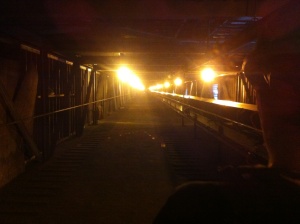
Looking down a coal conveyor tunnel at the Point Aconi Fire Generating Station. Photo Credit: Mark Ranjram
From the power plant, we headed to the Great Bras d’Or Channel, which connects the Bras d’Or Lakes (actually a marine estuary) to the Atlantic Ocean. Here we discussed the potential and challenges of tidal energy production from the large tides which pulse through the channel.
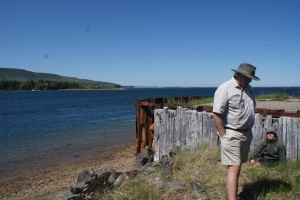
Dr. Bruce Hatcher explaining the feasibility of tidal energy in the Great Bras d’Or Channel. Photo credit: Kristen Leal
With the technical side of the day done, we proceeded to Baddeck, a small tourist down adjacent to Alexander Graham Bell’s family estate, for a sailing experience on a real sailing ship. As the cold Atlantic breeze whipped past us, we pointed out jellyfish in the water and eagles in the sky and I could not help but think about the deep connections between water and energy in Canada. What are the mechanisms by which we can take our role as stewards of our environment and balance that with our role as supporters of our families and communities; both being of critical importance to our species’ endeavour on this planet? The Mi’kmaq first nations on the island have an incredible commitment to both their environment and their communal economic success, and the non-indigenous population on the island has shown awesome commitment to sustainability and remediation, but how can we get that perspective to scale up to a population as large and as varied as our entire country? Thinking about Toronto, my hometown of roughly 2.5 million people, where green spaces are relatively plentiful for a city but are not necessarily part of our day-to-day, where the rivers are small and hidden away, and the lake is so large as to suggest infinite abundance, how do we develop that baseline of environmental understanding? And how do we translate that understanding amongst a finely discretized gradient of cultural, social, and economic motivations? The answers to these questions are not straight forward, but sometimes the most important step is to just open the sails and give yourself a chance to catch the wind.


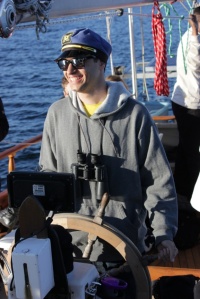
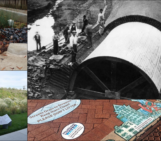


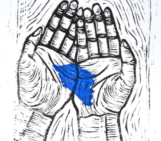
Pingback: The home of our hearts day 3: The coal story – mines and mine water remediation | Water Underground